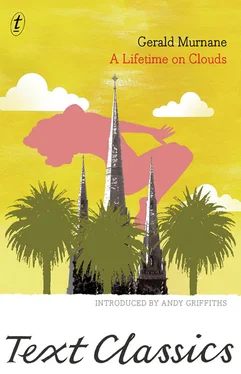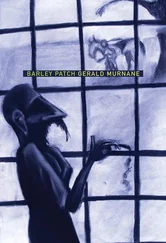The tropical rhythm affected everyone. The dancing grew furious. At the end of each chorus, some of the men sang words that were rather risqu é. Instead of the correct words ‘big fun’, they sang ‘big bums’. And a few of the more shameless women giggled behind their hands and waggled their own bottoms.
As the song neared its end, more people behaved suggestively or sniggered over double entendres. They forgot about the rest of America in the darkness all round them. They couldn’t have cared less about the thousands of Catholic parents trying to shield their children from the dangers of blue songs and films. They forgot everything except the sight of Jo Stafford swishing her grass skirt higher and higher in time with the wild pagan music and the off-colour words.
But nothing really evil happened. After a few minutes the song that had seemed to promise a lustful orgy came suddenly to an end.
Someone pulled back the drapes again. The cold grey light of dawn was spreading over the sky. The couples clasped hands and gathered at the windows while Eddie Fisher sang Turn Back the Hands of Time.
The men were all vaguely dissatisfied (like Adrian Sherd after he had listened to three Hit Parades on Sunday evening). All night they had heard about kisses that thrilled, kisses of fire, lips of wine, and charms they would die for. But now it was time to go home and they had done no more than dance the night away.
While the men were stealing a goodnight kiss from their girlfriends in the lobbies of their apartment buildings or on the porches of their frame houses, some of them might have found themselves humming a different kind of music.
It was not really hit music, although it often made the Hit Parade for a few weeks. When Adrian Sherd heard it he remembered that not everyone spent their evenings dancing in night clubs or folding charms in their arms. It was sad, lonely music — the theme from Moulin Rouge , or The Story of Three Loves or Limelight— and it seemed to come from countries very different from America.
When the people going home in America heard this music they wondered if there was some other kind of happiness that they had never found — and would never find as long as they spent their nights holding their loved ones dangerously near and tasting their lips.
One Monday morning Adrian’s friends asked him what he had done over the weekend. All he could tell them was that he had listened to the Hit Parades on the wireless. Seskis and Cornthwaite laughed and said they were always too busy to sit and listen to music.
But O’Mullane said, ‘The Hit Parade came in handy for me one night. I was lying out in my bungalow trying to think of an excuse to do it to myself and I heard this colossal song with Perry Como and a chorus of young tarts in the background. They were singing, “Play me a hurtin’ tune” over and over again. I beat time to the music while I did it. The last few lines nearly made my head drop off. I’m going to buy the record and use it again some day.’
Every few months, on a Sunday afternoon, Mrs Sherd took her three sons to visit her sister, Miss Kathleen Bracken.
Adrian knew his aunt Kath would have entered a convent when she was young if one of her legs had not been shorter than the other. Adrian’s mother called her a living saint because she went to daily mass in all weathers with her big boot clumping along the footpath.
Miss Bracken lived alone in a little single-fronted weatherboard house in Hawthorn. While his brothers ate green loquats or figs from the two trees in the backyard, Adrian admired his aunt’s front room.
Inside the door, near the light-switch, was a holy-water stoup in the shape of an angel holding a bowl against its breast. Whenever Aunt Kath walked past it she dipped her finger in the bowl and blessed herself. Adrian did the same.
There were three altars in the room: one each for the Sacred Heart, Our Lady of Perpetual Succour and St Joseph. Each altar had a statue of coloured plaster with a fairy-light burning in front of it (red for the Sacred Heart, blue for Our Lady and orange for St Joseph) and a vase of flowers. On certain feast days Aunt Kath burned a candle in front of the appropriate altar — a blessed candle obtained from the church on the feast of the Purification of Our Lady.
On a cabinet beneath a picture of Our Lady appearing to St Bernadette Soubirous was a flask of Lourdes water. Aunt Kath sprinkled a few drops on her wrists and temples when she felt off-colour. One day when Adrian’s youngest brother ran a long splinter under his fingernail, she dipped the finger in the flask before she poked at it with a needle.
Adrian liked to ask his aunt about little-known religious orders or puzzling rituals and ceremonies or obscure points of Catholic doctrine. It was his aunt who told him always to burn old broken rosary beads rather than throw them away (so they wouldn’t end up lying next to some dirty piece of garbage or be picked up by non-Catholics who would only make a mockery of them). She showed him leaflets about an order of nuns who dedicated their lives to converting the Jews, and another order who worked exclusively with African lepers. She knew all about the ceremony of tenebrae , in which the lights in the church were put out one by one. And one Sunday afternoon she took Adrian and his mother to a churching for a woman who had recently had a baby.
Whenever his aunt was talking, Adrian thought of her mind as a huge volume, like the book that the priest used at mass, with ornate red binding and pages edged with thick gilt. Silk ribbons hung out of the pages to mark the important places.
‘Why aren’t Catholics allowed to be cremated?’ he asked her.
She took hold of the dangling violet (or scarlet or green) ribbon and parted the gilt edging at the section containing the answer.
‘At one time, certain heretics or atheists used to have themselves cremated to show that their bodies couldn’t be resurrected after death. So the Holy Father issued a decree so that no Catholic would appear to be siding with the heretics.’
In a drawer in the front room Aunt Kath had a collection of relics of saints, each in a silk-lined box labelled CYMA or ROLEX or OMEGA. The relics were tiny chips of bone or fragments of cloth housed behind glass in silver or gilt lockets.
When Adrian had been younger he used to enjoy visiting his aunt. But after he had begun his visits to America he felt he was polluting her house, and especially the front room. He still read her magazines ( The Messenger of Our Lady, The Annals of The Sacred Heart, The Monstrance, The Far East ) but he kept away from her altars and relics. He was frightened of committing a sacrilege by touching them with his hands — the same hands that only a few hours before had been dabbling in filth.
One day when he had at least a dozen sins on his soul, his aunt showed him a new relic she had just received from Italy. She unpacked it from a box stuffed with tissue-paper.
‘Actually there are two of them,’ she said. ‘And I want you to have one.’
Adrian knew she prayed every morning that he would become a priest. Fortunately God saw to it that no prayers ever went to waste. His aunt’s prayers would probably be used to lead some other more worthy boy to the priesthood.
She lifted out two tiny envelopes and held one up to the light. Adrian saw a dark patch in one corner.
His aunt said, ‘They’re only third class relics — I’ve told you about the different classes of relics — but they were jolly hard to come by.’
She put one envelope in Adrian’s hand. ‘It’s from his tomb,’ she said. ‘Dust from the tomb of St Gabriel of the Sorrowing Virgin. St Gabriel had an extraordinary love for Holy Purity. He’s the ideal patron for young people to pray to today when there’s so much temptation about.’
Читать дальше












